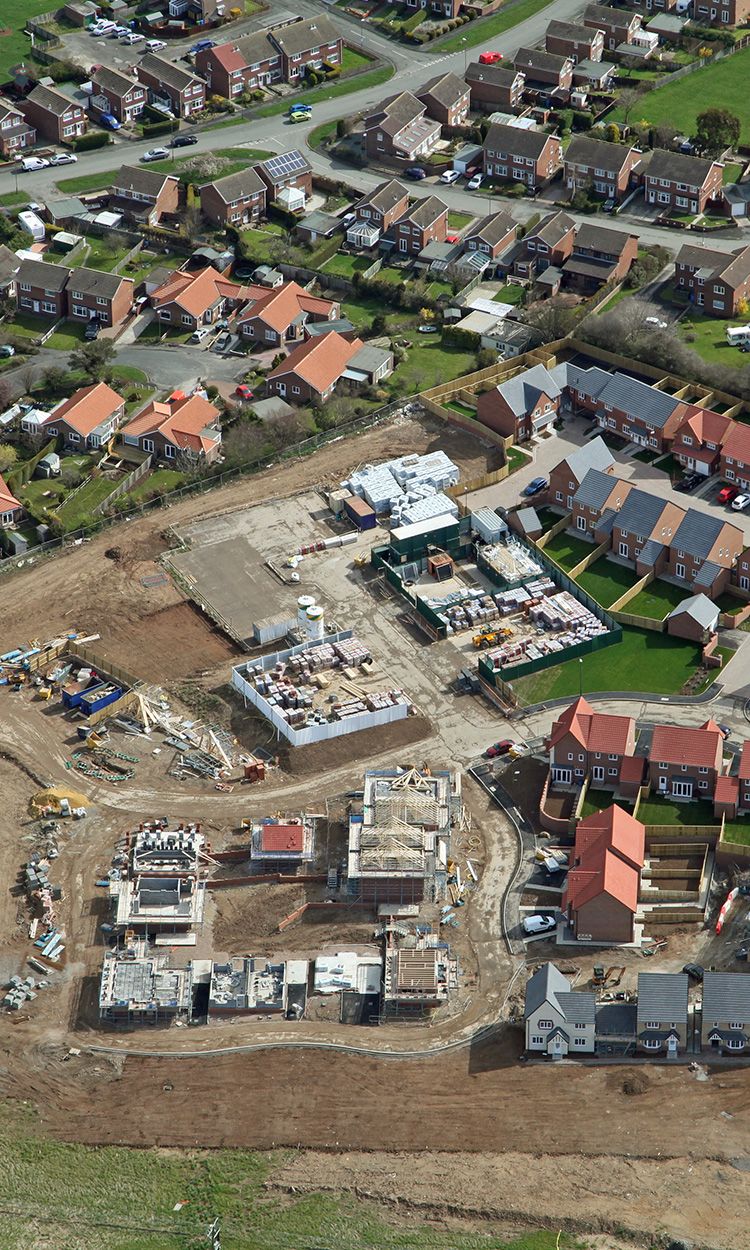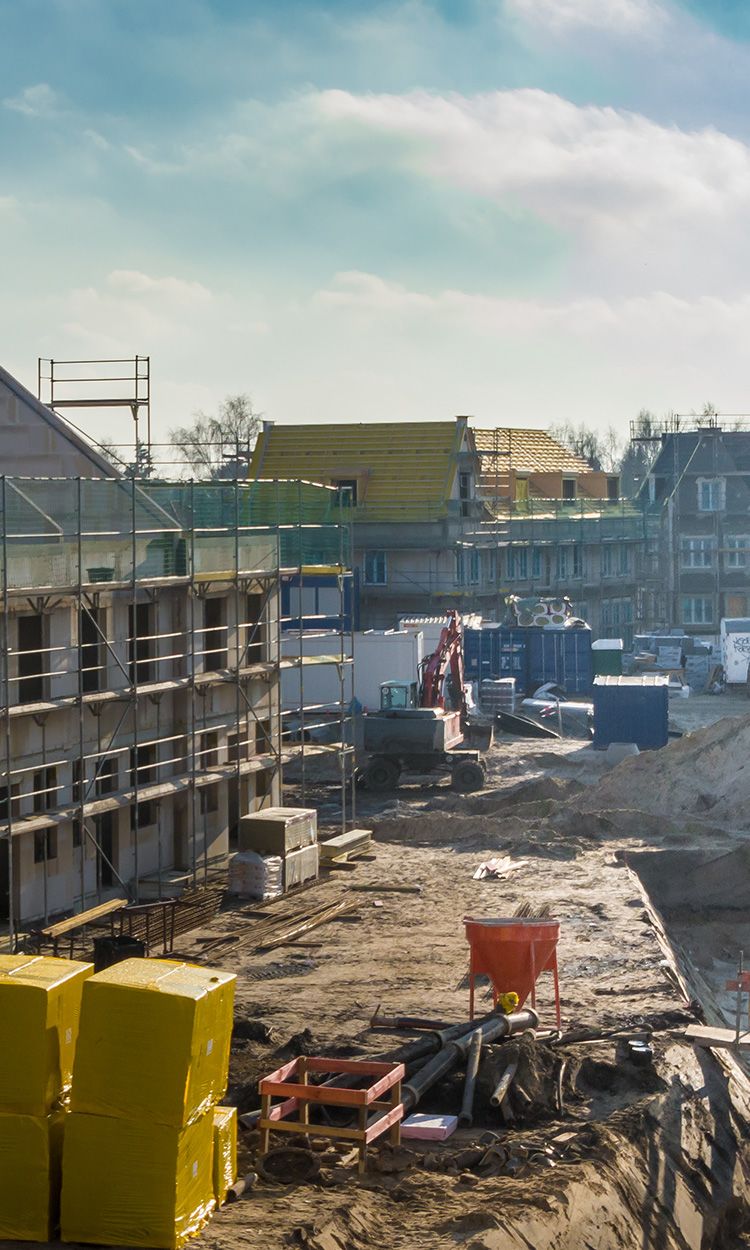The Future of Residential Property -
A Tale of Two Regions

The UK’s residential property market has always been consistent, solid and trustworthy. The speed of the vaccination programme, the relaxation of social distancing measures and Government support for both jobs and the housing market in 2020/21 kept confidence and activity high. According to Nationwide, UK house prices ended 2021 increasing by 10.4% marking the highest annual price growth since 2006 with the average UK home increasing by nearly £24,000 during 2021.
"The challenges facing the housing market have been well documented. But essentially not enough accessible housing is being built in the right areas to match the population growth trajectory. Nowhere is this more evident than in the regions we operate in."
2022 has already shown that is going to be complex and uneven year with competing forces (both domestic and international) impacting the market at different points. Our estate agent friends predict that UK house prices will climb by a more realistic 5% as mortgage rates rise and inflation bites in the midst of political uncertainty, global conflict, cost of living crisis and the emergence of a more adverse tax landscape.
The challenges facing the housing market have been well documented. But essentially not enough accessible housing is being built in the right areas to match the population growth trajectory. Nowhere is this more evident than in the regions we operate in. To address these complex challenges in the long term, it is necessary to dramatically increase housing supply now. The Government has set an ambitious target for 300,000 new homes per year and one million new homes by 2024. However this target even if it is met, will not be enough to address future population and demographic trends.
With population growth forecast to be around 20% in Oxfordshire by 2030 it is clear that despite major housing developments at sites across the county we are not building enough homes to satisfy that growth. All eyes are on whether the Oxfordshire Plan 2050 will help deliver on the greatly needed new homes and county’s infrastructure.
However it’s somewhat of a different story in Bath. Figures released by the Council in the first quarter of this year revealed that Bath & North East Somerset had exceeded its targets to deliver new homes for residents. Across Bath and North East Somerset, 184% of the required new housing had been delivered, almost double the target set in the Local Plan.
It’s clearly a tale of two regions which our experts will go into more detail throughout this report.
Finally we would like to thank our contributors who have helped make this report possible:

As well as:
Andrew Theban, Investment Manager

Angus Williams - Partner and Head of Residential Property, RWK Goodman

Chapter one
Market overview

Whilst reports show new house sales agreed remain well above the pre-pandemic norm, with the same true of mortgage approvals; the supply of homes for sale has not kept pace with the level of demand. This continuing imbalance is also driving price growth.
The looming spectre of interest rate rises, energy price crisis, cost of living and inflation rate rises will inevitably impact on disposable incomes. It is probable then that demand may taper off slightly as we progress into the next quarter. Simon McConnell, Partner, Carter Jonas, “This is no bad thing. Lessening demand will bring some balance back into the market. 2021 was the perfect storm fuelled by the stamp duty holiday and accumulated household savings. There will be some cooling off from the eyebrow raising prices rises, record number of transactions and a more sustainable level of house price growth”.
People are cautious of those rises and there will be no stamp duty holiday to fuel the market in 2022. However, as Simon adds, “There is a subtle difference between the market cooling off and a crash. Although activity levels in 2022 won’t be the same as 2021 we won’t see property price rises dropping significantly, if at all”.
People still want to move as their lifestyle needs and housing preferences have shifted. With increased hybrid working many people are reassessing what they want from their homes with a desire for more inside and outside space. However due to demand and serious stock shortages it will remain a sellers’ market with buyers having to pay a premium. John Gebbels, founder of Oxfordshire-based buying agent specialist OXON Property Search, “In February it was widely reported that there was a mere two and half months’ worth of property stock available across the UK with a third less property available year-on-year and a dramatic decrease in the number of all property types available apart from flats”
However, the expected slowdown in quarter two due to lack of supply didn’t happen. There were a number of sellers who ‘stayed put’ exercising caution around the rising interest rates, inflation and cost of living crisis. John adds, “It was a solid start to the year, albeit with lower transaction levels due to the impact of sales having been brought forward to meet the stamp duty deadline. The expected series of interest rate rises and more supply coming online saw price growth moderate. That lack of supply which had been a common theme over the course of 2021 started to ease up and the supply / demand imbalance began to address itself. But sellers retained the upper hand, especially in the countryside where people had had good lockdowns and were reluctant to put their properties on the market due to the lack of supply”.
"With increased hybrid working many people are reassessing what they want from their homes with a desire for more inside and outside space."
Quarter one also saw the number of overseas investors buying in the UK pick up, David Mackenzie, Partner, Carter Jonas added, “Overseas buyers have been absent from the UK property market for the last two years. The pandemic has caused constraints in the access of overseas investors and therefore investment capital flows. Now, as travel corridors have widened and look to remain that way, the UK is geared to welcome back international buyers. We should see overseas investors drive competition in the market and continue to fuel price growth throughout the year”.
And despite higher inflation and increases in interest rates, these are still low by historic standards. The rising cost of living and increased interest rates may change the landscape for some first-time buyers who still face significant barriers to home ownership as deposit requirements remain challenging. The good news is that 95% mortgages are once again available to first time buyers. Average interest rates on those mortgages remain low and there is continued political and industry focus on how we help more people access affordable and quality homes.
The lack of supply was well documented throughout the Spring. Though housing transactions were below the record levels from the same time in 2021; they remained above the average during the same period in 2020. Mortgage approvals were also above the pre-pandemic norm; though again below the levels seen during the same period in 2021. This significantly contributed to the continued price growth.
Chapter two
Insights: A Tale of Two Regions

Oxfordshire – insider perspective
With the worst of the pandemic behind us, normal service resumed in the UK property market with international buyers making their presence felt. Nowhere is this more evident than in Oxfordshire, John Gebbels adds, “Oxford continues to have a strong emotional pull on people – a number of overseas people study or work in Oxford at some point in their lives. The county is centrally located, an hour from London, Heathrow and Birmingham, is home to the world’s leading University, part of the golden triangle with Cambridge and London and with a number of high growth industries across life sciences, health, energy, robotics and AI, autonomous vehicles and space-led data applications. These industries continue to attract skilled overseas professionals who want to live within the ring-road or the more desirable villages and market towns across the county”.
Oxfordshire continues to have one of the strongest regional economies in the UK which is another influence on the market. Foreign direct investment (FDI) is one of the biggest drivers of success for the area and the East-West Rail Project will re-establish a rail link between Cambridge and Oxford and transform the region’s connectivity. This is one of the most important infrastructure projects in the South East and will be a huge boost for the region’s accessibility.
The Oxford to Cambridge Arc has been widely touted as one of the greatest opportunities for economic growth in the UK and could, with the right infrastructure, deliver much needed new homes. There is also an emerging trend for more strategic planning, such as the Oxfordshire Housing and Growth Deal which has committed to building 100,000 new homes by 2031 to address the housing crisis and support the economic growth. Gurpreet Sawhney, Residential Property Partner, RWK Goodman, “One of the challenges is the green belt particularly around Oxford and the Government’s proposed garden villages in South Oxfordshire, Vale of White Horse and West Oxfordshire are not the silver bullet to increasing supply as they will only deliver around 10,000 new homes. It is clear the region will need more innovative schemes like the partnership between Legal & General and Oxford University to provide discounted homes for university staff and research graduates on university land alongside homes for general sale”.
"Oxfordshire continues to have one of the strongest regional economies in the UK which is another influence on the market."
Oxford is one of the UK’s fastest-growing cities and has one of the world’s leading technology clusters. However with affordability issues similar to those in London it lacks accessible residential space essential for the University to continue to attract research graduates and businesses’ skilled workers. Oxford will remain a highly lucrative investment opportunity for residential landlords, both domestic and international, especially those that have a strategy targeting students or young professionals.
The post-pandemic hybrid working model has benefited the Oxfordshire market enormously. The north western edge of The Chilterns was often seen as the distance limit for a daily commute into London. City professionals now only going into their offices one or two days a week have started to look and settle further afield. Oxfordshire offers an escape from the more traditional commuter locations / suburban villages of the Home Counties with their price premiums. It’s the most accessible county from London that offers vast areas of unspoilt countryside, convenient market towns and truly rural villages with excellent road and rail access. Fast growing access to speedy broadband and improved tech and rail connectivity are also fuelling that flight. You can be in Marylebone from rural Buckinghamshire on a fast train in less than 40 minutes!
Though it’s very much a tale of two halves across the county, John adds “Those well-established historic market towns like Thame, Abingdon, Wantage and Witney still attract a lot of interest and command high prices especially those within the proximity of a direct station into London. Didcot and Bicester are an attractive proposition for buy-to-let (BTL) investors, young families and first-time buyers because of the volume of new builds and rail links, though perhaps less coveted by purchasers looking for larger family homes. Yet the villages around those towns continue to be highly popular”.
John spoke to us in Thame about the changes he sees in Oxfordshire's property market.
Building new homes is an important step towards alleviating affordability constraints, which hamper economic growth by pricing out workers, and ultimately reduce the attractiveness of an area for businesses if they believe they will struggle to recruit. However, even with considerable activity around new builds, the county has suffered from a massive housing shortage for some time. House builders despite their best efforts have not been able to keep up with what is needed due to a myriad of factors which our experts go into in more detail in chapter three.
"Oxfordshire offers an escape from the more traditional commuter locations / suburban villages of the Home Counties with their price premiums."




Bath and the South West – insider perspective
The South West has also seen an influx of people leaving London seeking a better lifestyle with more space and bigger gardens. David Mackenzie, “In Bath there has been more demand for modern properties that don’t require listed building consent making them easy to adapt to the evolving needs of modern families and multi-generational living. There has also been an increase in interest for out-of-town or village properties both old and new. Thankfully recently Bath and the surrounding areas has seen a considerable rise in new build homes and developments. The market towns such as Corsham, Trowbridge and Melksham have become more desirable and from Chippenham central London can be reached by train in just over an hour whilst surrounded by prime countryside providing easy access to rural Wiltshire”.
As buyers continue to re-evaluate their life-style choices, the drivers for the South West have been the well-regarded schools, transport networks and the attraction of the coast. Angus Williams, “Bath and the South West continues to top polls and appeal to people. House prices in Bath and the surrounding areas have been soaring with more and more people moving from London to live in the area. As well as being the UK’s only UNESCO world heritage site, with its ancient Roman Baths, Bath is one of the country’s safest cities with its traditional heritage, contemporary culture, green spaces and some of the finest independent shops in the UK”.
Even before the pandemic with electric trains cutting the journey times to London, Bath and the South West were appealing to those buyers priced out of London but not ready to give up on city life. With people now adopting hybrid working as the norm and the much-maligned Crossrail finally arriving in Paddington journey times into the City will be much quicker.
"As buyers continue to re-evaluate their lifestyle, the drivers for the South West have been the well-regarded schools, transport networks and the attraction of the coast."
However, the South West has also suffered from the supply and demand issue, David adds, “We’ve had buyers sell in London, coming down to the South West thinking they were in a strong position with any potential purchase and then having to go into Airbnb due to the lack of stock. This same lack of stock is deterring elderly people from down-sizing as they are reluctant to list their property and then have nowhere to go. Combined with nervousness around rising living costs, interest rate rises and global conflicts people are staying put which is exacerbating the problem”.
David gives us his overview of the residential property market in Bath and the surrounding areas.
Chapter three
What’s next…

The year began with the well documented challenges around the availability of stock. The market enjoyed a good start with housing and mortgage activity continuing to defy economic conditions, with average property prices continuing to rise. The mortgage industry was particularly busy. This strong momentum and confidence in house prices led many lenders to relax underwriting criteria and expand the variety of products they had on offer, including increasing the number of products available to customers with small deposits at higher loan-to-value ratios.
Bank funding and future mortgages
With mortgage rates on the rise, though still “relatively cheap” in historic terms, Adrian Moloney, Group Intermediary Director at OSB Group, commented, “We entered 2022 with a strong pipeline of new business and demand remained strong in our buy-to-let and residential sectors. The mortgage industry was particularly busy following on from an exceptional 2021. In the first quarter with the rise in the cost of living, we saw borrowers rush to lock into fixed rate mortgages as swop rates rose in a bid for stability. However, lenders are still keeping rates relatively low as they fight for market share. Those individuals looking to re-mortgage and refinance have still managed to achieve fairly good deals”.
The economic fallout from the war in Ukraine, rising inflation and decline of real incomes has resulted in home buyers having much less money. National insurance contributions in April increased just as inflation started to rise significantly. Consumer confidence plunged to its lowest levels since 2021 when the UK was in the depths of winter lockdown. The Spring also marked the return of more recognisable and predictable conditions in the UK housing market.
Adrian adds, “It was welcome news for borrowers last year that The Bank of England announced that it was considering simplifying mortgage lending by removing the stress-testing part of affordability assessments. The consultation closed in May, but it is unlikely that there will be any immediate changes to the UK’s mortgage market as lenders will still want to stress test to insure against interest rate rises as they want to lend responsibly. And of course in recent months, we’ve seen the cost of mortgages rise”.
"The war in Ukraine, rising inflation and decline of real incomes has resulted in home buyers having much less money"
New technologies
Lockdowns forced the mortgage industry to integrate more technology into their business and streamline the process. Traditionally the sector has been slower than others in the financial sector to adopt new technologies; but the pandemic has permanently changed how people looking to buy or re-mortgage a home are seeking lenders. Recent advances in digital technology have resulted in significant improvements in the mortgage application process.
However, as Douglas Miller, Director, Lansdown Financial Services adds, “The adoption of open banking helps to verify income, speed up identity confirmation and customer onboarding, and even helps with credit decisions. Lenders can make faster decisions, while also ensuring the security of customer data; but these applications don’t necessarily understand the relationship, local market or how best to value the property”.
"AI and digitalisation make it more efficient for all parties."
John Gebbels, “In the past, prospective homebuyers would always insist on seeing the property in person. This is understandable as buying a home is incredibly expensive and emotive. The pandemic turned this on its head with strict lockdowns and quarantines people had to resort to digital alternatives. This has long been the case for some overseas investors who were happy for a virtual tour and to buy on agent recommendation. However digital-first millennials who have grown up online and already trust digital channels for their banking and communicating eagerly adopted this approach”.
The rise of fintechs has also caused a shift in the mortgage lending market and are revolutionising traditional approaches to home buying by creating new options that are helping people become homeowners more easily and more quickly. Molo is the UK’s first, fully-digital mortgage lender using the power of technology to make real-time lending decisions via a digital journey to give customers quicker answers and a better overall experience. StepLadder is a London-based start-up that offers a model that uses a rotating savings and credit association (ROSCA) to help its customers raise the deposit they need in order to buy a specific property.
These fintechs have reimagined the mortgage application process, using AI and digitalisation to make it more efficient for all parties. People are embracing fintech solutions in personal banking so using fintech when applying for a mortgage seems a natural next step.
Aaron Taghdiri, Director, Lansdown Financial Services, “Applying for a mortgage has traditionally been a very long and tiresome process. Borrowers must submit huge amounts of information: bank statements, proof of income, evidence of a deposit etc and would require multiple meetings with their financial adviser before the mortgage was even approved. However, the rise of digital channels has streamlined the data gathering process and the mortgage adviser can now focus on educating people on their options and have much more valuable conversations”.
Cryptocurrency for mortgage transactions?
In September 2021 Coadjute, property and mortgage software company, announced plans to launch the UK’s first mortgage cryptocurrency, enabling banks to issue a mortgage stablecoin on their network to improve the movement of mortgage funds. Coadjute aims to connect the people in the UK housing market, enabling every party in a property transaction to share data and track live progress, from beginning to end. By using blockchain technology to verify every party involved, encrypt and timestamp all the data in transit; the platform claims to provide live information from other systems with certainty, accuracy and security.
Gurpreet Sawhney, “There is no doubt that cryptocurrency mortgages are coming, the question is when? In the UK, no major mortgage lender has yet announced that they will accept cryptocurrency for mortgage payments. There are still only a few lenders such as Natwest, Nationwide and Barclays that will accept deposits from the sale of cryptocurrency, but not service the debt. So we don’t see mortgage lenders accepting it any time soon”.
Residential property solicitors are also understandably nervous. While the future looks promising for cryptocurrency, until the regulators provide more guidance law firms won’t have the know-how to check source of wealth and funds on cryptocurrency. There is currently very limited appetite for sellers to accept cryptocurrencies. If you want to use your crypto investments towards a house purchase, this will generally involve the conversion into government-issued currency such as sterling. The antipathy towards cryptocurrency stems partly from its much-publicised association with criminality and money laundering.
The challenge is to find residential property lawyers who are prepared to accept the cryptocurrency proceeds into their client account. There are not many. Gurpreet adds, “Money laundering regulations require residential property solicitors to take steps to identify who their client is and verify that any funds they receive are not from the proceeds of crime. This means that the provenance of the assets must be understood, including the way they have been traded and with whom”.
"The future looks promising for cryptocurrency, but until the regulators provide more guidance law firms won’t have the know-how to check source of wealth and funds"
Rise of multi-generational living
Multi-generational living is nothing new. Country estates have long had dower houses and other properties within their grounds for extended family to live in. In the Victorian and Edwardian eras, it was common for multi-generations to live under one roof. Always popular with our Continental neighbours in the UK this went into sharp decline with the concept of the nuclear family. However, the pandemic and forced separation from our extended family during lockdowns made many rethink the logic of nuclear family living.
The benefits of multi-generational living are obvious: shared financial responsibility, childcare costs can go down, collective contribution to household bills, closer family bonds, greater sharing of inter-generational knowledge and lower or no elderly-care costs. Combining purchasing budgets can allow for greater scope when looking for a property. Buying a property with a parent or adult child can, if proper advice is taken at the time, also reduce inheritance tax (IHT) liabilities. However as Ed Vidnes, Private Client Partner, RWK Goodman comments, “Certainly with the recent pandemic in mind, coupled with an ageing population we are often consulted by clients about the impact of inheritance tax and/or care needs and care fees on their estates. At the same time with children struggling to get on the property ladder, clients are more open minded as to how they meet these various challenges. Multi-generational living can of course address many of these concerns, but only if proper advice is taken by all parties at the time, so as they don’t fall foul of some nasty tax and care charging permutations that can otherwise trip up the unadvised”.
"By 2050 one in four people will be over 65."
Jayne Martins, Family Law Partner, RWK Goodman, on ring-fencing purchases, “It is becoming increasingly common for family members, particularly parents to help their children get onto the property ladder usually by providing money for a deposit. We are also seeing far more second marriages or relationships later in life where families have already accrued property and assets and they wish to preserve this for their children and grandchildren and therefore need to ring fence the asset in the event of a divorce or separation. It is helpful for families to really think about how they can protect their assets and who they intend to really benefit from them in the future”.
The UK has an ageing population, by 2050 one in four people will be over 65. As the cost of living in retirement homes soars, multi-generation living could be another method of families coming together to counter the effects of rising house prices, the cost of childcare and lack of affordable elderly social care.
Jo Kent, Residential Property Senior Associate, RWK Goodman, “Our estate agent colleagues have been reporting an increase in multi-generational living. With the shortage of new homes being built, coupled with rising living costs and the increasing cost of providing care for elderly parents it makes sense to combine financial forces and upsize into a property large enough to house three or more generations”.
Upsizing, the new downsizing?
Downsizing had been gathering momentum for years. However, in the post-pandemic world peoples’ priorities have changed as they embrace the working from home / hybrid working lifestyle. As part of the drive to more multi-generational living a contradictory trend has been emerging with people looking to upsize with family members.
People tended to focus a lot more on their families and homes during the 2020 and 2021 lockdowns, becoming more aware of what’s immediately around them. These have propelled people across all generations to really consider what, where and with whom their next home should be.
People have been upsizing so they have more space for family and friends to stay, renovations and DIY projects (a growing trend fuelled by the pandemic), business ventures, personal space, additional room for children and growing families and office space to accommodate hybrid working.
Jo adds, “The pandemic and lockdowns inevitably created a demand for larger homes. Space is a huge prompt for many wanting to upsize and the advantages of upsizing are clear - more storage space, further bedrooms to accommodate a growing family, spare rooms that can be rented out for additional income. All of which can help build future wealth”.
"People tended to focus a lot more on their families and homes during the 2020 and 2021 lockdowns, becoming more aware of what’s immediately around them."









The demise of the ‘amateur’ landlord?
Between March and September 2020, pandemic rules meant that landlords had to give tenants rent holidays if they needed them. Evictions were banned and the bailiffs could not be called in until the end of May 2021. Whereas this was welcome news for thousands of renters who may have been struggling to pay their rent, some have argued that it marked the “beginning of the end” for the ‘amateur’ landlord.
Much maligned over the years, the small-time amateur landlord is a uniquely British phenomenon: 70% of the UK’s private landlords let just one home often as an additional income source as well as working. Whereas on the Continent private landlords are often companies or individuals with large property portfolios running a proper business.
Adrian Moloney, “For decades the buy-to-let market has been an attractive investment for individuals, with many looking to move towards limited company status. However, the red-hot housing market of the last 18 months was a great opportunity for buy-to-let investors to sell properties and benefit from the equity they had built up. Rising inflation and interest rates combined with changes to taxation and legislation forced many smaller landlords to reassess their portfolios and the market has become more professional as a result of this”.
"The small-time amateur landlord is a uniquely British phenomenon: 70% of the UK’s private landlords let just one home often as an additional income source"
Does this signal the end of the amateur landlord? Not necessarily but the trend is for a more professional approach to property investing, Stuart Bradney, Director – Deal Origination, Carbon Funding Consultants adds, “The end of the remaining Covid-19 restrictions in March aided a revival in a recently muted sector. Large portfolio landlords who have incorporated into limited companies will continue to own and add to their portfolios. With equity values currently volatile, property still remains an attractive investment option. However, the future is less about direct ownership of buy-to-let in favour of build-to-rent (BTR) as landlords and property investors seek higher yields as professional tenants will pay a premium for quality new builds. For investors able to play the long game, attract good, long-term tenants and see their investment (albeit initially higher in new builds) pay off over time the BTR is well worth exploring”.
Simon McConnell (Carter Jonas) and Stuart Bradney (Carbon Funding Consultants) give their overview of the changing property market in Oxfordshire and the UK.
There are a wealth of additional benefits that new homes offer investors when it comes to boosting their profit margins. Running costs are considerably lower as new builds are substantially more energy efficient and the better level of build quality and compliance means that maintenance costs are also reduced. The BTR proposition also offers the opportunity to invest in the market with a more hands-off approach which can save investors a considerable amount of time and money.
Build-to-rent has taken longer to grow in popularity in the UK due to our significant focus on home ownership. But rising house prices have made it even more difficult for first-time buyers in urban areas to get onto the housing ladder, meaning many are renting until much later in life. Today’s young professionals are more amenable to renting as people enjoy the flexibility and the build-to-rent’s communities with a focus on lifestyle.
"The BTR proposition offers the opportunity to invest in the market with a more hands-off approach"
Stuart added, “With professional tenant demand continuing to rise, and not being met by the existing rental market, it is proving an increasingly popular asset class among property investors”.
Government incentives
"We need a Government strategy that keeps the whole market on an even keel as opposed to particular aspects."
It has been widely reported that the Government’s Help to Buy scheme will have cost around £29 billion in cash terms by 2023. Whereas the scheme has supported over 300,000 house purchases with first time buyers making up 82% of these, Stuart concludes with, “Schemes like Help to Buy simply drives up the cost of new stock in popular areas further conflating the supply and demand problem. Subsidised home ownership adds to house price inflation and doesn’t fuel all sectors of the market. Funding for home ownership schemes does not provide good value for money”.
Government incentives over the last two years have allowed for artificial injections of cash which means it’s hard to predict what will happen for the rest of the year. It’s clear we need a Government strategy that keeps the whole market on an even keel as opposed to particular aspects.
What lies ahead for the housebuilding sector?
The residential property market has seen a rise in workloads, outputs and confidence in the sector as it has adapted to the many challenges over the last two years. Housebuilding in particular is leading this growth as confidence remains strong. However, the industry is not without its own challenges: ageing workforce (35% of the workforce are over 50), poor image, lack of diversity, Brexit uncertainty, supply chain issues, access to foreign labour and a planning system that has reached its lowest point.
"People can’t afford to move where their talent can be matched with opportunity. Businesses can’t afford to grow and create jobs. This is no more evident than in the regions we operate in."
The Government’s aim to create a more diverse and competitive housing market is subject to doubt. The focus to date has been on numbers with questions around delays to fulfilling their housebuilding manifesto promises (300,000 new homes annually with 1m over this Parliament). Around 194,000 new homes were built in 2020/21 – a considerable way off!
In essence we do not have enough homes in the right places. People can’t afford to move where their talent can be matched with opportunity. Businesses can’t afford to grow and create jobs. This is no more evident than in the regions we operate in.
Grant Westall-Reece, Partner & Head of Residential Development, Bidwells, “Doubt about the future planning system and delays to planning reform have created uncertainty for housebuilders and residential property developers. The Government needs to set out a long-term strategy for the planning system with clear proposals on local plans, funding and land availability. More than half of local authorities do not have an up-to-date plan. The lack of local planning means the system is not ‘plan-led’, creates uncertainty and prevents a more strategic approach to development. Many planning authorities are wanting to support housing delivery to match local needs but many councillors are stalling the process, as development doesn’t win votes!”.
Grant gives us his overview of housebuilding in Oxfordshire and the UK.
Many eyes were on the new Planning Bill which was scheduled for Spring which would have potentially made it easier for developers to convert unused commercial buildings into housing in England. However in the face of fierce criticism from their own backbench MPs, the Government announced it will now deliver its planning proposals through the Levelling Up and Regeneration Bill later this year.
Will these policies be sufficient to bridge the gap?
According to recent research from the Building Cost Information Service, the cost of building a new build house – currently at around £2,375 per sqm – is set to climb by almost £18,000 per unit. This jump could cost UK housebuilders around £3.2bn per year. The estimated construction cost of an UK average property is at present just under £175,000. However, if the overall build costs climb as expected with the cost of construction materials and labour the average cost of a new build home could increase to over £192,000.
View of the national housebuilder and the SME housebuilder
Sarah Gadsden, Director, Cantay Estates, “Planning uncertainty coupled with significant building cost inflation is creating a perfect storm for SMEs housebuilders. Years of funding cuts have left many planning departments struggling with capacity, particularly given the amount of supporting information now required for each application. It is impossible to predict how long it will take even for simple applications to be determined, and the upfront cost has spiralled. New regulations such as the incoming biodiversity requirements are adding to the uncertainty. This in turn has increased demand for consented sites leading to steamy land prices at a time of rapid build cost inflation. It is becoming difficult for SMEs to remain viable and many are asking themselves whether to start new projects when it is impossible to know how long they will take or what they will cost”.
Grant adds, “The pressure on housing is everywhere. The need for new housing, coupled with a shortage of sites available, is fuelling demand for land for residential development. There are a larger number of players throwing time and money at limited opportunities - for every site that comes to market there are now up to 20 companies sharpening their pencils and bidding competitively (pre-pandemic that figure would have been around 10-12). Essentially there is not enough land either physically available or available with planning. This is a significant barrier to meeting housing demand”.
A recent report found that overall council spending on core planning and development functions had fallen by more than 25% over the past decade. This has resulted in massive resourcing issues within local authority planning teams with many leaving to go into the private sector. Those who remain are severely demoralised claiming stress and burnout with caseloads regularly exceeding what is deemed as comfortable. Sarah adds, “Unless something is done to fix what many see as a broken system, the Government will never reach its housebuilding targets. The planning log jam results in uncertainty and spiralling costs threatening housebuilders’ ability to complete projects while maintaining viability. The Government needs to create a streamlined planning process otherwise many SMEs will exit the industry, making it less diverse and giving consumers less choice”.
Clearly the Government needs to do more to support SME housebuilders to maintain competition in the marketplace. Their role in the industry has sharply declined; in 1988 they built around 39% of new homes, by 2020 this had dropped to 10%. The loss of these housebuilders has clearly affected the industry’s ability to meet its targets. Access to finance is another reason for the decline as SME housebuilders often have limited cash resources as they build to sell to finance the next build.
"Overall council spending on core planning and development functions have fallen by more than 25% over the past decade"
Mark Edmonds, Managing Director, Taylor Wimpey Oxfordshire, “Whereas there is strong demand for new homes the sector continues to be held back by the issues that Sarah has referenced. By the nature of what we do, housebuilders are very good at solving problems. We just need things to stay relatively stable for a period. The Government keeps making kneejerk changes without really understanding the implications for the industry evidenced by the fact there have been ten housing ministers in as many years [editor’s note – average time in office under one and half years].”
The change in Building Regulations which set the standards in England for the design, construction and alteration of buildings that came into force in June means that all new build homes must adopt low carbon technology to reduce their CO2 output.
Mark adds, “We welcome the Government’s desire that the UK reach net zero CO2 by 2050 in a collective effort to combat climate change. We want to be part of the solution and in 2021 we launched our new environment strategy, setting out how we will help protect our environment for future generations and reduce the impact of the homes and developments we build. We have set ourselves the targets to reduce operational carbon emissions intensity by 36% by 2025, from a 2019 baseline and reduce carbon emissions intensity from our supply chain and customer homes by 24% by 2030, from a 2019 baseline”
Clearly more new homes are vital to meet housing demand. Although in the short term they will not address the affordability pressures in some regions, they are an essential first step to ensure that demand can be met in the long term. The sector needs certainty and a clear direction from the Government. Reforms to the Planning system are desperately needed as well as more resources to address delays which are clearly affecting both SME and national housebuilders. Skills shortages in both planning and construction also needs to be addressed, Mark concludes with, “If these challenges are dealt with by the Government it will be possible to boost housing supply and affordability in the long term and meet housing targets”.
Conclusions

We conclude with our experts looking at how you can preserve your wealth for future generations.
The tax treatment of residential property portfolios has changed significantly over recent years. Once popular tax structures and vehicles may no longer be appropriate and what were relatively straightforward taxes are much more complex. Stuart Bradney, “Whereas property acquired in personal names is still the most conventional approach, with the recent tax legislative changes, we have seen clients acquire and even transferring their existing properties into a limited company structure for tax efficiency particularly those who are higher tax rate payers”.
Trusts are another popular structure that enable an individual or a company to hold certain assets on behalf of an individual or group of people known as beneficiaries. Ed Vidnes, “You can place rental properties into a trust whether they are new acquisitions, or you have owned them for some time. It may be possible to defer payment of capital gains tax (CGT) on gains inherent in properties at the time of transfer. Trusts can also allow inheritance tax efficient transfer of value to subsequent generations earlier than would be the case if giving to children/grandchildren themselves. Control can be maintained by the donors/trustees despite the successful transfer of value for tax purposes”.
"Once popular tax structures and vehicles may no longer be appropriate"
Parents and grandparents with substantial property portfolios may get to the point that they do not actually want to hold investment property that is generating more income than they need (and which they are paying income tax on) and growing in value and so is at risk of increasing their IHT exposure on death. Ed adds, “The simplest way of addressing this problem would be to give one or more of their rental properties to their adult children or grandchildren. As long as they survive making the gift by at least seven years, the property will fall outside their estate on death and escape IHT. However, this sort of transfer usually triggers a substantial CGT charge. Again, use of a suitable form of trust can allow deferral of such a charge”.
Trusts can also be a way of protecting assets from bad marriages. In post-pandemic times and with the squeeze on personal finances, parents are increasingly reluctant to provide financial assistance to their adult children because they are concerned that the money could be lost in any subsequent break-up or divorce. Jayne Martins, “We are often approached by anxious parents who are keen to ensure that family wealth intended for their children and grandchildren won’t fall into the hands of their estranged son or daughter-in-law. Trusts to preserve family wealth for future generations can be an instrument to protect family assets and should be considered. However, family trusts where the child or grandchild is a beneficiary will be taken into account in divorce proceedings so it will be increasingly important for the trust to be robustly drafted and the intentions of the trustees and beneficiaries to be clear”.
Pre-nuptial agreements, post-nuptial agreements and cohabitation agreements are also a far more useful tool to protect family wealth. Jayne adds, “They allow you to set out in advance what you want to happen financially if your marriage ends in divorce or your cohabiting relationship breaks down. Properly drafted they will be enforceable in court and protect inherited/gifted wealth or other assets owned before marriage. These are sensible ways of ‘divorce proofing’ your assets”.
Not since the 1930s has inheritance tax played as big a role in the economy. Along with Stamp Duty this still remains one of the most unpopular and emotive of taxes. According to Canada Life, IHT payments are set to almost double to £10 billion by 2030. Today’s baby boomers have benefited from generous pensions, well paid secure jobs and soaring property values. On paper trillions in assets are forecast to be inherited over the next twenty years. With people living longer the age at which the next generation will benefit and how tax efficiently you can transfer your wealth will be key considerations of any estate planning strategy.
Another potential way to protect family wealth for the next generation to ensure that it doesn’t end up in the hands of the tax man as part of your inheritance tax liability is to invest in shares traded on the Alternative Investment Market (AIM). Andrew Theban, Investment Manager, “Many AIM companies qualify for business relief. Under current UK tax rules, any shares in these companies can pass to the next generation, free of IHT, once you’ve held onto them for two years. The key is balance - it’s often best to view your AIM shares as a component of your portfolio”.
[Editor’s note - investing in AIM carries higher risk than the average equity portfolio and it’s important to seek advice before investing. The tax relief may also change at any time.]
Deciding on how best to transfer your wealth is rarely simple. Complicated family dynamics compounded by second marriages, children with differing financial needs and expectations makes passing on your wealth a highly sensitive topic. As life expectancy increases, the next generation are likely to be in their sixties when they inherit any money. Ed adds, “However if you have surplus money it can make financial sense to make gifts to your immediate family. They will benefit from when they need it most and it can, subject to being fully advised of the rules around gifting, be highly efficient from an IHT planning perspective providing you live for seven years after the gift”.
"Today’s baby boomers have benefited from generous pensions, well paid secure jobs and soaring property values. "
Andrew concludes, “The issue of wealth and estate planning is often a taboo subject for many families. Many people naturally feel awkward having a conversation about such an emotive subject. Careful estate planning is in everyone’s best interests and allows for a much smoother transition of your wealth to future generations and for your loved ones to inherit in the most tax-efficient way”.
The message is clear: it is never too early to start having those conversations around wealth and estate planning; and taking professional advice is crucial to navigating the intricacies of our ever-chasing legislation.

